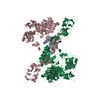+Search query
-Structure paper
| Title | Structure of the proteolytic enzyme PAPP-A with the endogenous inhibitor stanniocalcin-2 reveals its inhibitory mechanism. |
|---|---|
| Journal, issue, pages | Nat Commun, Vol. 13, Issue 1, Page 6084, Year 2022 |
| Publish date | Oct 18, 2022 |
 Authors Authors | Sara Dam Kobberø / Michael Gajhede / Osman Asghar Mirza / Søren Kløverpris / Troels Rønn Kjær / Jakob Hauge Mikkelsen / Thomas Boesen / Claus Oxvig /  |
| PubMed Abstract | The metzincin metalloproteinase PAPP-A plays a key role in the regulation of insulin-like growth factor (IGF) signaling by specific cleavage of inhibitory IGF binding proteins (IGFBPs). Using single- ...The metzincin metalloproteinase PAPP-A plays a key role in the regulation of insulin-like growth factor (IGF) signaling by specific cleavage of inhibitory IGF binding proteins (IGFBPs). Using single-particle cryo-electron microscopy (cryo-EM), we here report the structure of PAPP-A in complex with its endogenous inhibitor, stanniocalcin-2 (STC2), neither of which have been reported before. The highest resolution (3.1 Å) was obtained for the STC2 subunit and the N-terminal approximately 1000 residues of the PAPP-A subunit. The 500 kDa 2:2 PAPP-A·STC2 complex is a flexible multidomain ensemble with numerous interdomain contacts. In particular, a specific disulfide bond between the subunits of STC2 and PAPP-A prevents dissociation, and interactions between STC2 and a module located in the very C-terminal end of the PAPP-A subunit prevent binding of its main substrate, IGFBP-4. While devoid of activity towards IGFBP-4, the active site cleft of the catalytic domain is accessible in the inhibited PAPP-A·STC2 complex, as shown by its ability to hydrolyze a synthetic peptide derived from IGFBP-4. Relevant to multiple human pathologies, this unusual mechanism of proteolytic inhibition may support the development of specific pharmaceutical agents, by which IGF signaling can be indirectly modulated. |
 External links External links |  Nat Commun / Nat Commun /  PubMed:36257932 / PubMed:36257932 /  PubMed Central PubMed Central |
| Methods | EM (single particle) |
| Resolution | 3.06 - 5.02 Å |
| Structure data |  EMDB-15217: PAPP-A dimer in complex with a dimer of the inhibitor STC2  EMDB-15219: PAPP-A dimer in complex with endogenous STC2 inhibitor. EMDB-15220, PDB-8a7d: EMDB-15221, PDB-8a7e: |
| Chemicals |  ChemComp-NAG:  ChemComp-ZN:  ChemComp-CA: |
| Source |
|
 Keywords Keywords |  HYDROLASE / Metzincin metalloprotease Inhibitor complex HYDROLASE / Metzincin metalloprotease Inhibitor complex |
 Movie
Movie Controller
Controller Structure viewers
Structure viewers About Yorodumi Papers
About Yorodumi Papers








